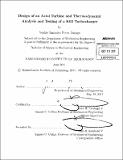| dc.contributor.advisor | John H. Lienhard V. | en_US |
| dc.contributor.author | Perez Zuñiga, Yoshio Samaizu | en_US |
| dc.contributor.other | Massachusetts Institute of Technology. Dept. of Mechanical Engineering. | en_US |
| dc.date.accessioned | 2012-01-12T19:35:48Z | |
| dc.date.available | 2012-01-12T19:35:48Z | |
| dc.date.copyright | 2011 | en_US |
| dc.date.issued | 2011 | en_US |
| dc.identifier.uri | http://hdl.handle.net/1721.1/68540 | |
| dc.description | Thesis (S.B.)--Massachusetts Institute of Technology, Dept. of Mechanical Engineering, 2011. | en_US |
| dc.description | Cataloged from PDF version of thesis. | en_US |
| dc.description | Includes bibliographical references (p. 65-66). | en_US |
| dc.description.abstract | A novel humidification dehumidification desalination system was developed at the Rohseneow Kendall Heat Transfer Laboratory. The HDH system runs by having different pressures in the humidifier and dehumidifier. One of the components that will keep the different pressures is an expander. The expander specification is to work with a pressure ratio of 1.2 while having a high efficiency. Two approaches were developed to achieve this result, one was through the design of a turbine and the second was through the selection and testing of a car turbocharger. The design of a turbine is given in detail and follows the process given in "Design of High- Efficiency Turbomachinery and Gas Turbines" by David Wilson. The final design of the turbine blades was sand cast. Due to the sand casting process, cavitation on the blade material was shown and testing of the blades was not pursued for fear of fast fracturing. The second option of selecting a turbocharger is shown and the process which led to its selection is explained. Through such process a K03 turbocharger was selected to be suitable to run at the low pressure ratios with a moderate efficiency. Testing of the K03 was conducted. The static-to-static isentropic efficiency calculated was 53% ± 11% for a pressure ratio of 1.2 while the total-to-total isentropic efficiency 60% ± 14% at a pressure ratio of 1.2. The high error associated with the efficiencies are due to the turbine experiencing small temperature drops in the order of 10°C or less. The K03 turbocharger is meant to run at higher pressure ratios, in the order of 2 with a manufacturer specified efficiency of 70%. Running the K03 at a pressure ratio of 1.2 decreases the efficiency since its not specified to run at those low pressure ratios. If a turbine or a turbocharger is designed for the exact specifications of the desalination system, it can work with low pressure ratios and be highly efficient. | en_US |
| dc.description.statementofresponsibility | by Yoshio Samaizu Perez Zuniga. | en_US |
| dc.format.extent | 66 p. | en_US |
| dc.language.iso | eng | en_US |
| dc.publisher | Massachusetts Institute of Technology | en_US |
| dc.rights | M.I.T. theses are protected by
copyright. They may be viewed from this source for any purpose, but
reproduction or distribution in any format is prohibited without written
permission. See provided URL for inquiries about permission. | en_US |
| dc.rights.uri | http://dspace.mit.edu/handle/1721.1/7582 | en_US |
| dc.subject | Mechanical Engineering. | en_US |
| dc.title | Design of an axial turbine and thermodynamic analysis and testing of a K03 turbocharger | en_US |
| dc.type | Thesis | en_US |
| dc.description.degree | S.B. | en_US |
| dc.contributor.department | Massachusetts Institute of Technology. Department of Mechanical Engineering | |
| dc.identifier.oclc | 771617774 | en_US |
